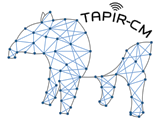The aim of the TAPIR-CM project is to design architectural solutions for 5th generation (5G) and beyond mobile networks. To this end, the project will leverage as enablers SDN (Software Defined Networking) and network functions virtualization (NFV) to boost the transformation of current networks into software-centric paradigm, enabling flexibility and agility in the whole system lifecycle. The evolution of the SDN architecture itself enables high scalability and programmability and, therefore, it is an important objective of the project. The second enabler component that the TAPIR-CM project will resort to is machine learning. The capability to forecast with high accuracy the behavior and characteristics of data traffic that mobile users will consume through machine learning techniques is pillar to improve the performance of multiple of network functions, including scheduling, mobility management, orchestration and resource allocation, among the others.
The TAPIR-CM project will tackle this challenge by first identifying the main 5G enablers that still require further enhancements, in particular in the areas of access and core network, and management. The scientific and technical challenges are diverse and multi-disciplinary, spanning all the layers in the network protocol stack – from application to physical layers – and involving simultaneously wireless, switched and optical networks. To address such heterogeneous set of challenges, the research consortium consists of four research teams with complementary skills required to fulfill the objectives of the project.
The different objectives that TAPIR-CM will address are heterogeneous, as mentioned above. To make the network architecture flexible and easy to upgrade, TAPIR-CM will specifically focus on solutions for designing control/user separation of 5G network functions and programmable multi-architecture switching. The functional programmability (P4) of the switches enables the delegation of functionalities providing higher scalability and adaptability. Through the definition of a measurement framework, data from core and radio access network will be employed by machine learning algorithms for traffic classification and forecasting at micro and aggregate level. The project will leverage such information for specific optimizations (e.g., load balancing). As demonstration, TAPIR-CM has the precise objective to prototype the designed solutions for optimization in end-to-end network slicing context. The completion of such objectives will lead to a set of solutions improving dramatically the existing network architecture paving the path for beyond 5G networks. Such solution enable high flexibility and adaptability of the architecture to the environment achieved by means of machine learning and softwarization techniques.
The main results of the project would be:
- (1) publications in top journals and well-known conferences
- (2) contribution to standardization activities in the relevant SDO fora (IEEE, IETF, ONF, ETSI, etc.)
- (3) development of testbeds to highlight the main contributions of the project, to be maintained after project’s completion
- (4) collaboration with the relevant industrial partners to foster their leadership in 5G technologies.
All project results, news, working proposals, publications, contributions to conferences, patents and relevant information will be available in a project specific website and on popular social media such as Facebook, Twitter, Linkedin and Youtube, which will be updated regularly. Additional dissemination activities of project results and demo will take place in La Noche de los Investigadores, and in form of press release over relevant websites like Madri+d Notiweb o EurekAlert! Science News.










